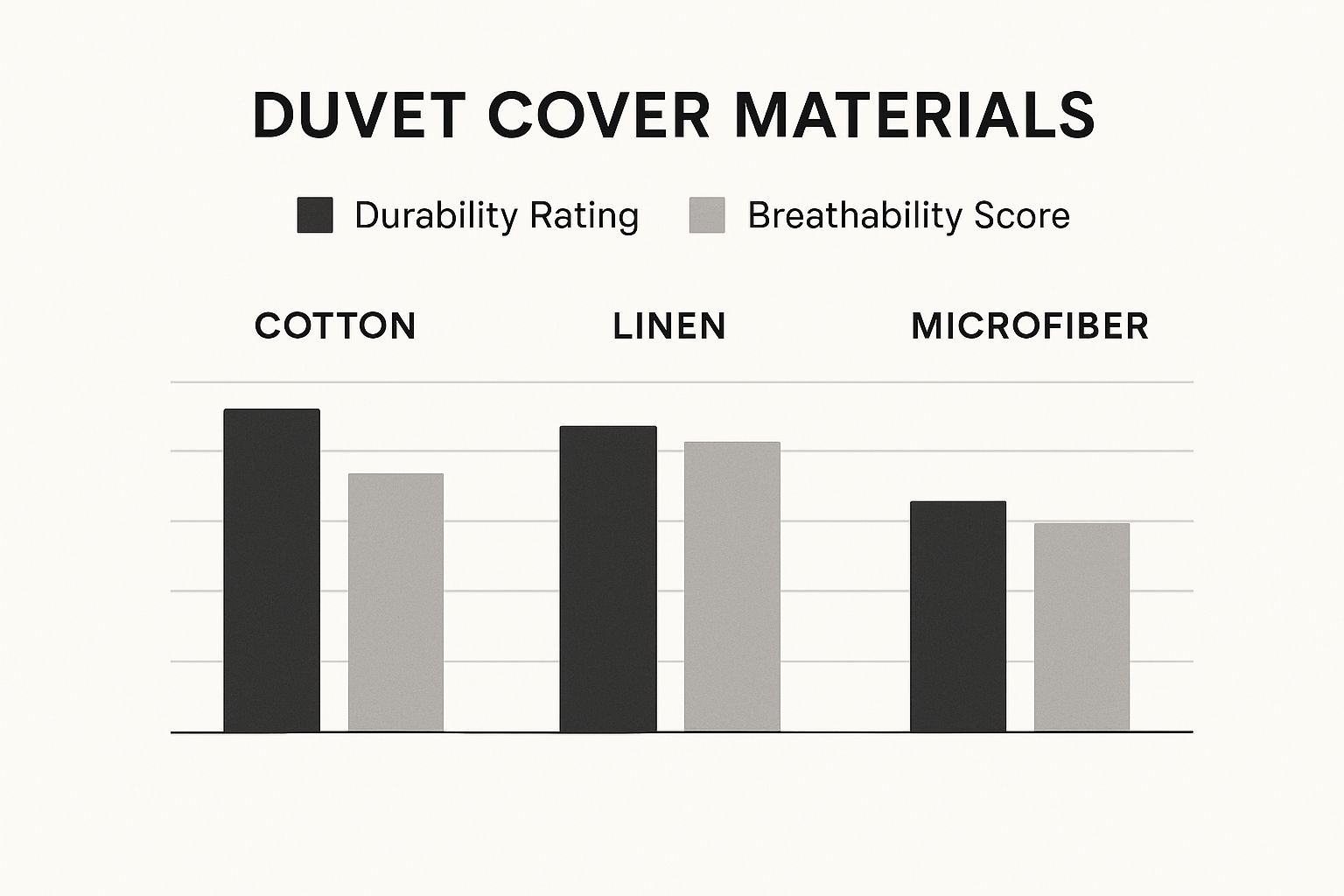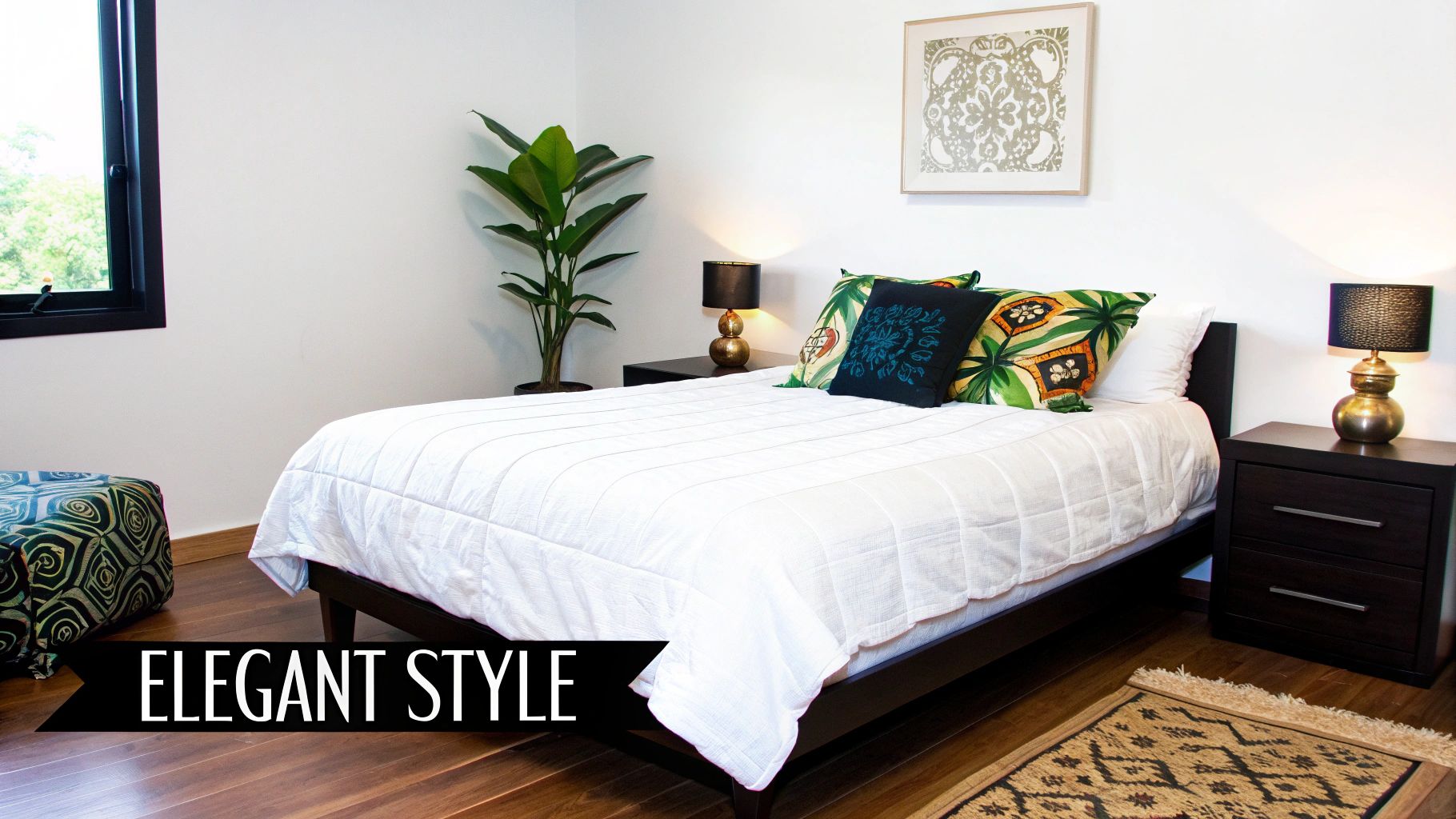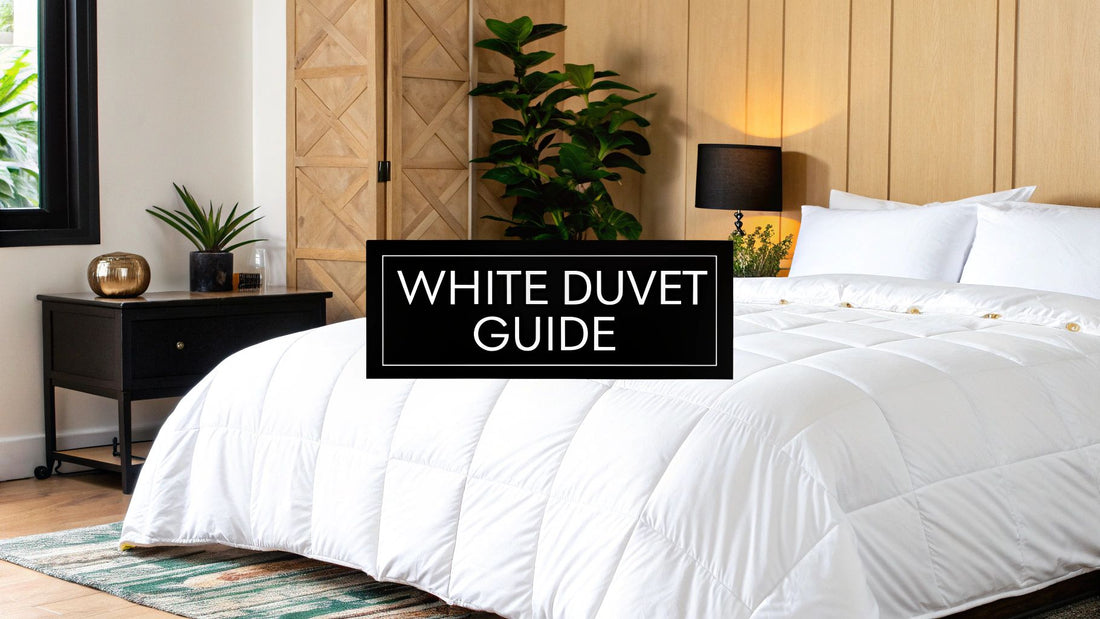Finding the perfect white duvet cover in NZ isn't just about picking a colour; it's about finding the right balance of material, weave, and quality to suit our unique climate. The best choices almost always come back to breathable natural fibres like long-staple cotton or European linen, which keep you comfortable year-round, from muggy summers to crisp winter mornings.
Your Guide to Selecting the Perfect White Duvet Cover
A white duvet cover is more than just bedding. It's the very foundation of a calm, inviting bedroom. For Kiwi homes, choosing the right one means looking past the simple aesthetic and really thinking about how different fabrics will perform through our seasons. The aim is to find a piece that not only looks stunning but actually improves your sleep, night after night.
This is becoming even more relevant as the local market changes. New Zealand's home bedding sector is set to grow significantly, with a projected compound annual growth rate (CAGR) of 6.4% between 2025 and 2035. This isn't just a number; it shows a real shift in what we Kiwis want—a move towards quality craftsmanship and sustainable materials, and away from mass-produced synthetics.
Matching Materials to Your Sleep Style
The fabric of your duvet cover is, without a doubt, the most important factor for comfort. Different materials offer unique benefits, and what works for a hot sleeper might not be ideal for someone who's always cold.
Let’s look at the top contenders:
- Organic Cotton Percale: Think of that crisp, cool feeling of a freshly ironed shirt. That's percale. It’s incredibly breathable, making it a dream for anyone who tends to overheat at night or for getting through those humid summer evenings.
- Linen: This is a real superstar for its breathability and moisture-wicking ability. Linen is fantastic all year—it feels cool in the summer and offers a surprising amount of warmth in winter. Plus, its relaxed, slightly crumpled texture brings a touch of effortless style to any room.
- Bamboo: If you're exploring different textures, it's worth checking out bamboo duvet cover options, which are known for their silky softness and breathability. Bamboo is also hypoallergenic and a natural temperature-regulator, giving it a truly luxurious feel against the skin.
This quick comparison highlights how different materials stack up for our homes.

As you can see, natural fibres like linen and cotton consistently win on breathability, which is a massive plus for staying comfortable in New Zealand's variable climate.
To help you decide, here’s a breakdown of the most common fabrics you'll find.
Comparing White Duvet Cover Materials for NZ Homes
Choosing a fabric can feel overwhelming, but it really comes down to your personal preference for feel and how much maintenance you're prepared for. This table breaks down the essentials.
| Fabric Type | Best For | Feel & Appearance | Care Level |
|---|---|---|---|
| Linen | Hot sleepers & a relaxed, natural look. | Gets softer with every wash. Naturally textured and breathable. | Easy – machine washable. Embraces a natural crinkle, so no ironing needed. |
| Cotton Percale | Those who love a crisp, cool hotel-bed feel. | Smooth, matte finish. Light and airy. | Medium – can be prone to wrinkling, may need a quick iron for a pristine look. |
| Cotton Sateen | Sleepers who prefer a silky, smooth touch. | Subtle sheen and a soft, drapey feel. Slightly heavier than percale. | Easy to Medium – less prone to wrinkling than percale, but can be less breathable. |
| Bamboo | Sensitive skin & eco-conscious buyers. | Exceptionally soft, silky, and smooth. Naturally hypoallergenic. | Easy – typically machine washable on a gentle cycle. Dries quickly. |
Ultimately, the right fabric is the one that feels best to you and fits your lifestyle. Whether it's the rustic charm of linen or the cool crispness of percale, you can't go wrong with a quality natural fibre.
Beyond the Fabric: Weave and Fit Matter Too
Once you've settled on a material, the weave is the next thing to consider, as it determines the fabric's final texture. A percale weave gives you that light, airy feel with a matte finish. On the other hand, a sateen weave creates a silkier, slightly heavier fabric with a gentle lustre, which can feel a bit warmer against the skin.
Your choice between percale and sateen is purely personal—it's about whether you prefer the crisp coolness of a classic hotel sheet or the smooth drape of silkier bedding.
Finally, don't forget about the fit! This is crucial for a tidy, well-made bed. Sizes can vary a little between brands, so it pays to double-check the measurements before you buy. To make sure you get it right, take a look at our complete guide on standard duvet cover sizes in NZ. It'll help you match your duvet inner perfectly with its new cover, preventing that annoying bunching or slipping.
What Separates a Good Duvet from a Great One?

When you're on the hunt for a white duvet cover in NZ, you’ll quickly see that the prices can vary wildly. So, what actually justifies spending a bit more? Often, the difference between a good duvet cover and a truly great one comes down to the small, considered details that go far beyond the fabric type.
Think of a higher-end duvet cover as an investment piece for your home. It’s designed to handle countless nights and weekly washes without losing its charm or falling apart. It’s these thoughtful elements that give it staying power.
The Hallmarks of Quality Craftsmanship
The things that define a premium duvet cover can be subtle, but they make a world of difference to how it lasts and feels day-to-day. The first thing I always check is the stitching. Look closely at the seams—you want to see tight, even stitching that doesn't look like it will pull or fray after one trip through the washing machine.
The closure system is another dead giveaway of quality. Both buttons and zips can be great, but only if they're done well.
- Buttons: On a premium cover, you'll often find buttons made from durable, natural materials like mother-of-pearl or wood. They should feel solid and be sewn on securely, sometimes with reinforced stitching, so you aren't hunting for them in the machine later.
- Zips: A quality zip should be hidden or 'invisible' to keep the look clean and seamless. It needs to glide effortlessly without catching on the fabric—a sure sign it won't break on you after a few months.
A tell-tale sign of a thoughtfully designed duvet cover is the inclusion of internal ties. These simple loops, one in each corner, are non-negotiable for me. They stop your duvet inner from bunching up into a lump at the bottom of the bed, ensuring everything stays smooth and comfortable.
Ethical Production and Sustainable Choices
For many of us Kiwis, how something is made is just as important as how it looks. The New Zealand household linen market, which hit around USD 418.77 million in 2023, is seeing a real shift towards sustainability. People want to know where their products come from, pushing brands to be more transparent about their supply chains. You can read more about the latest findings on the NZ household linen market to see this trend in action.
This means it's worth looking for certifications that back up a brand's claims.
Key Certifications to Look For
When you invest in a quality piece, you're often supporting better environmental and social standards, too. There are two key certifications I always tell people to keep an eye out for:
- OEKO-TEX® Standard 100: This is one of the most trusted labels for textiles tested for harmful substances. If you see this tag, it means every single component—from the thread to the buttons—has been tested and is safe for your health.
- Global Organic Textile Standard (GOTS): This certification takes things a step further. It doesn't just guarantee the organic status of the fibres; it ensures the entire manufacturing process is environmentally and socially responsible.
Choosing a duvet cover with these labels means you're bringing home more than just a beautiful product; you're making a conscious choice. For instance, a GOTS-certified organic cotton cover or one of the beautifully crafted items from our collection of linen duvet covers in NZ showcases a commitment to both luxury and responsibility.
By paying attention to these details, you'll find a white duvet cover that not only looks and feels incredible but also aligns with your values and is built to last.
Styling Your White Duvet for a Magazine-Worthy Look
A crisp white duvet cover is the ultimate blank canvas for your bedroom. But let's be honest, a blank canvas can sometimes feel a little... empty. The secret to transforming your bed from just simple to truly stunning isn't about piling on clutter; it's all about layering with intention, texture, and a touch of personality.
Think of it like dressing up a classic white shirt. The duvet is timeless and versatile, but it’s the accessories that really make the outfit your own. This is your chance to play with different textures and colours to build a look that feels both carefully curated and incredibly inviting.
Creating Depth with Texture
The quickest way to add warmth and visual interest to an all-white bed is to layer different materials. A bed that’s rich in texture practically begs you to touch it, which instantly makes the whole room feel more luxurious and comfortable. We're getting rid of any flat, one-dimensional feeling and aiming for real depth.
Start by introducing a mix of textiles through cushions and throws. Here’s how you can get started:
- Chunky Wool Throws: A thick, knitted wool blanket casually draped over the end of the bed adds instant cosiness—perfect for those cooler Kiwi nights.
- Velvet Cushions: Nothing beats the contrast of a plush, rich velvet against crisp white linen or cotton. A couple of velvet cushions in a deep jewel tone like emerald green or navy can add just the right amount of drama.
- Patterned Linen Euro Pillows: Those large square pillows, or Euros, are fantastic for propping up against the headboard. Choosing some in a subtle stripe or a classic floral print adds a layer of design without overwhelming the calmness of the white.
The real trick is to mix things up, not match them perfectly. A perfectly symmetrical, rigid arrangement can feel a bit stiff and unlived-in. Instead, aim for a balanced but relaxed look that feels effortlessly put together.
This blend of smooth, rough, soft, and plush textures creates a sensory experience that makes your bed the undeniable centrepiece of the room. It’s a simple technique professional stylists use all the time to make a space feel complete.
Drawing from New Zealand Interior Styles
The beauty of a white duvet is that it can adapt to pretty much any aesthetic, fitting seamlessly into the popular interior styles we see across New Zealand homes. Whether you lean towards a relaxed coastal vibe or a more structured urban look, your bedding can be the anchor that ties everything together.
Let’s look at two popular NZ styles for a bit of inspiration:
- Laid-Back Coastal: To nail this look, think natural and relaxed. Pair your white duvet with cushions in soft, sandy neutrals, muted blues, and gentle greys. A light, textured throw made from linen or woven cotton is the perfect finishing touch. The goal here is to create a serene, breezy atmosphere that feels like a bach by the sea.
- Modern Minimalism: For a sleeker, more contemporary feel, the focus is on clean lines and a very restrained colour palette. You could style your white duvet with just one or two statement cushions in a bold, solid colour like charcoal or a deep terracotta. Keep the textures smooth and sophisticated—think high-quality sateen or a simple linen throw folded neatly at the foot of the bed.
Completing the Look with Furniture and Lighting
Finally, it’s important to look beyond the bed itself. The elements surrounding it play a huge role in how your styled duvet is perceived. The right headboard, for instance, can frame the bed beautifully. A warm timber headboard is a natural fit for a coastal aesthetic, while a sleek upholstered or minimalist metal one works perfectly with a modern design.
Your choice of nightstands and lighting also contributes massively to the overall mood. Matching timber nightstands with soft, warm table lamps can enhance that cosy, inviting feeling. On the other hand, minimalist floating shelves and sculptural wall sconces will reinforce a clean, contemporary vibe. By thinking about these finishing touches, you create a cohesive and polished bedroom that genuinely looks like it's been pulled straight from the pages of a magazine.
How to Keep Your White Bedding Looking New

There’s nothing quite like the elegance of a crisp, white duvet cover, but I know what you’re thinking—how on earth do you keep it looking that way? It can feel a bit daunting, but the good news is that maintaining that brilliant, fresh-from-the-store look is much simpler than you might expect.
With just a few smart techniques, caring for your white duvet cover NZ will feel less like a chore and more like a satisfying ritual. You can forget about harsh chemicals and complicated routines. The real secret to long-lasting brilliance is a gentle, consistent approach to washing, drying, and treating stains as they happen. It’s all about working with the fabric, not against it.
Mastering the Wash Cycle
The foundation of brilliant white bedding is built right in your washing machine. While it’s tempting to crank up the heat, a warm (not hot) gentle cycle is actually far better for the fibres. Overly hot water can weaken natural materials like cotton and linen over time, leading to premature wear and tear.
A golden rule is to always wash your white duvet cover separately from other items. This is especially true for towels, which are notorious for shedding lint that can cling to the fabric and make it look dull. A mild, eco-friendly liquid detergent is all you need to get the job done without stripping the material. For some extra pointers, you can find great tips on how to effectively wash whites to really maintain your duvet cover's pristine look.
One of the biggest mistakes I see people make is using fabric softener. These products coat the fibres in a waxy residue that actually traps dirt and body oils, which can lead to that dreaded yellowing over time and even reduce the fabric's natural breathability.
Natural Whitening and Stain Removal
Before you even think about reaching for the bleach, let's talk about some effective, natural alternatives that are much kinder to your bedding and the environment. You probably have these in your pantry already.
- Baking Soda: Just add half a cup of baking soda to your wash cycle along with your usual detergent. It’s a fantastic natural brightener and deodoriser, helping to lift stubborn grime and keep your whites looking sharp.
- White Vinegar: During the final rinse cycle, pour in half a cup of distilled white vinegar. It works wonders to dissolve any lingering detergent residue, leaving your duvet cover feeling incredibly soft without needing fabric softener. And don't worry, the vinegar smell completely vanishes as it dries.
When the inevitable spill happens—like coffee or makeup—the key is to act fast. Immediately blot the stain with a clean, damp cloth. Whatever you do, don't rub, as this just pushes the stain deeper into the weave. For most stains, a simple paste of baking soda and water applied for about 30 minutes before washing does the trick. If you're working with tougher materials, our specific guide on how to wash linen sheets has more tailored advice.
Proper Drying and Smart Storage
How you dry your duvet cover is just as crucial as how you wash it. My top tip? Whenever you can, line-dry your white bedding outside. The sun is a natural bleaching agent and will help keep your duvet cover brilliantly white, plus you can’t beat that fresh, air-dried scent.
If you have to use a machine, always opt for a low heat, gentle setting. Over-drying at high temperatures can damage the fibres and cause them to yellow. A great hack is to toss in a few wool dryer balls—they help fluff up the fabric and can even shorten the drying time.
It's also interesting to see how global markets affect the cost of quality bedding here in New Zealand. The NZ cotton bed linen market, for instance, saw a sharp decline to $3.8 million in 2024, which is a massive drop of about 96.9% from the previous year. This kind of volatility, often driven by supply chain issues and import costs, directly impacts what Kiwis pay for premium items like a beautiful white duvet cover.
Where to Shop for Bedding in New Zealand
Alright, you know what you’re looking for in a quality duvet cover. So, where do you actually find the perfect white duvet cover NZ retailers have waiting for you? Our local market has a fantastic mix of options, from big-name department stores to specialist online boutiques, and each has its own strengths.
Figuring out where to go is really about knowing what each type of store does best. Large department stores are brilliant for seeing a whole range of brands in one go. You can physically compare the feel of different weaves and weights side-by-side.
On the other hand, boutique linen specialists—both online and on the high street—tend to offer a more curated selection. They're the ones who'll have a deeper focus on premium materials like authentic European flax linen or certified organic long-staple cotton.
Shopping Smart In-Store
Nothing beats the advantage of touch when you're shopping in a physical store. Don't be shy about it! Unfold a corner of the duvet cover, feel the fabric against your cheek, and get a good look at the craftsmanship up close.
Here are a few things I always look for:
- Fabric 'Hand-Feel': Does it have that crisp, cool feel of a great percale, or is it more like the silky-softness of sateen? Rub a bit of the fabric between your fingers to really gauge its smoothness.
- Stitching Quality: Check out the seams. They should be straight, tight, and completely even. This is one of the most reliable signs of a durable, well-made piece.
- Closure Details: Have a play with the zips or buttons. A quality closure will feel sturdy and operate smoothly without catching or snagging the fabric.
When you shop in person, you can properly assess the weight and drape of the fabric—something that’s almost impossible to judge online. It gives you a real sense of how it will actually look and feel on your own bed.
Vetting Online Retailers
Let's be honest, the convenience of shopping online is hard to beat, especially when you want access to niche brands that don’t have a local storefront. When you’re ready to buy a white duvet cover nz online, a little bit of homework can make all the difference.
Before you click 'add to cart', take a few moments to do this:
- Read the Return Policy: A trustworthy retailer will always have a clear and fair return policy. This is your safety net in case the shade of white or the texture isn't quite what you pictured.
- Order Fabric Swatches: This is my top tip. Many specialist online stores offer fabric swatches, sometimes for free or for a very small fee. It is hands-down the best way to confirm the colour, feel, and quality before you commit.
- Check for Kiwi Reviews: Actively look for reviews from other New Zealanders. Their feedback can give you priceless, real-world insight into things like local shipping times, customer service experiences, and how the duvet cover actually performs over time.
Got Questions About White Duvet Covers? We Have Answers

Choosing a white duvet cover is a big part of creating that bedroom sanctuary you've been dreaming of. To help you feel completely confident in your decision, we’ve put together answers to some of the questions we hear most often from fellow Kiwis.
This is all about the practical side of things—the details that really matter when it comes to choosing and caring for your bedding so you can enjoy it for years.
Don't let the fear of upkeep stop you from enjoying the timeless elegance of white bedding. With the right care, a high-quality white duvet cover is a durable and beautiful investment that stays pristine.
Let's get into the nitty-gritty, from debunking thread count myths to finding the best fabrics for our unique climate.
What Is the Best Thread Count?
Honestly, for New Zealand's climate, chasing a super high thread count isn't the be-all and end-all. What matters far more is the quality of the fibre and the type of weave.
We've found the sweet spot is a thread count between 300-500, but only when it's made from high-quality, long-staple cotton. A crisp percale weave, for example, feels cool and breathable, which is just perfect for our summers. On the other hand, a sateen weave has a silkier, slightly warmer feel that's lovely during the cooler months. Anything much higher can sometimes trap heat and feel surprisingly stuffy.
How Often Should I Wash My Duvet?
As a general rule of thumb, washing your white duvet cover every one to two weeks is a good rhythm to get into. This simple routine is the best way to prevent the build-up of natural body oils and dust that can lead to that dreaded yellowing over time.
Of course, if you use a top sheet between you and your duvet, you can easily stretch this out to every three or four weeks. The only non-negotiable? Wash it straight away if you have any spills or stains.
Is Linen a Good Choice for NZ Homes?
Yes, absolutely. Linen is a fantastic choice for Kiwi homes, mainly because of its natural temperature-regulating properties. It’s incredibly breathable, which helps keep you cool and comfortable on a humid summer night, yet it also provides a surprising amount of warmth in winter.
It definitely has a more relaxed, naturally crumpled look compared to crisp cotton, but that's part of its charm. Best of all, linen is incredibly durable and just gets softer and more beautiful with every single wash.
Ready to create your own serene bedroom sanctuary? Explore the curated collection of luxurious linen and cotton bedding at The Foxes Den and find the perfect white duvet cover for your home today.


